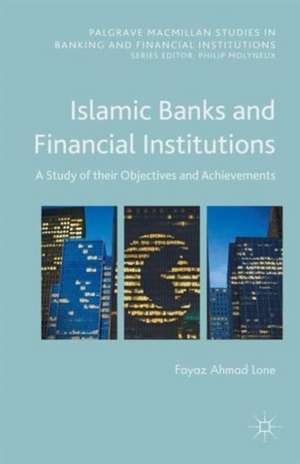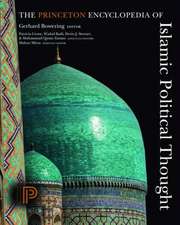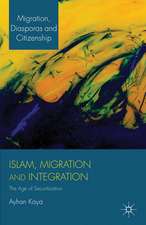Islamic Banks and Financial Institutions: A Study of their Objectives and Achievements: Palgrave Macmillan Studies in Banking and Financial Institutions
Autor Fayaz Ahmad Loneen Limba Engleză Hardback – 29 noi 2015
Din seria Palgrave Macmillan Studies in Banking and Financial Institutions
- 9%
 Preț: 1028.27 lei
Preț: 1028.27 lei - 17%
 Preț: 359.44 lei
Preț: 359.44 lei - 9%
 Preț: 907.74 lei
Preț: 907.74 lei - 15%
 Preț: 694.04 lei
Preț: 694.04 lei - 15%
 Preț: 638.43 lei
Preț: 638.43 lei - 15%
 Preț: 643.34 lei
Preț: 643.34 lei -
 Preț: 389.11 lei
Preț: 389.11 lei - 15%
 Preț: 669.97 lei
Preț: 669.97 lei - 15%
 Preț: 642.51 lei
Preț: 642.51 lei - 15%
 Preț: 642.51 lei
Preț: 642.51 lei - 15%
 Preț: 649.06 lei
Preț: 649.06 lei - 15%
 Preț: 639.25 lei
Preț: 639.25 lei - 15%
 Preț: 640.06 lei
Preț: 640.06 lei - 18%
 Preț: 752.88 lei
Preț: 752.88 lei - 15%
 Preț: 640.06 lei
Preț: 640.06 lei - 15%
 Preț: 645.47 lei
Preț: 645.47 lei - 18%
 Preț: 884.35 lei
Preț: 884.35 lei - 15%
 Preț: 641.20 lei
Preț: 641.20 lei -
 Preț: 386.39 lei
Preț: 386.39 lei - 15%
 Preț: 643.34 lei
Preț: 643.34 lei -
 Preț: 388.72 lei
Preț: 388.72 lei -
 Preț: 396.40 lei
Preț: 396.40 lei - 15%
 Preț: 642.51 lei
Preț: 642.51 lei - 15%
 Preț: 638.76 lei
Preț: 638.76 lei - 15%
 Preț: 639.73 lei
Preț: 639.73 lei - 15%
 Preț: 637.59 lei
Preț: 637.59 lei -
 Preț: 387.75 lei
Preț: 387.75 lei - 15%
 Preț: 641.20 lei
Preț: 641.20 lei - 15%
 Preț: 640.88 lei
Preț: 640.88 lei -
 Preț: 389.70 lei
Preț: 389.70 lei - 15%
 Preț: 648.24 lei
Preț: 648.24 lei - 15%
 Preț: 638.43 lei
Preț: 638.43 lei - 15%
 Preț: 641.20 lei
Preț: 641.20 lei - 15%
 Preț: 638.76 lei
Preț: 638.76 lei -
 Preț: 391.61 lei
Preț: 391.61 lei - 15%
 Preț: 641.20 lei
Preț: 641.20 lei - 15%
 Preț: 643.34 lei
Preț: 643.34 lei - 15%
 Preț: 641.71 lei
Preț: 641.71 lei -
 Preț: 390.63 lei
Preț: 390.63 lei - 15%
 Preț: 641.71 lei
Preț: 641.71 lei - 15%
 Preț: 644.95 lei
Preț: 644.95 lei - 15%
 Preț: 645.79 lei
Preț: 645.79 lei - 15%
 Preț: 645.79 lei
Preț: 645.79 lei - 15%
 Preț: 638.76 lei
Preț: 638.76 lei - 15%
 Preț: 640.06 lei
Preț: 640.06 lei - 15%
 Preț: 640.06 lei
Preț: 640.06 lei - 15%
 Preț: 643.34 lei
Preț: 643.34 lei - 15%
 Preț: 642.51 lei
Preț: 642.51 lei - 15%
 Preț: 640.06 lei
Preț: 640.06 lei - 18%
 Preț: 1125.86 lei
Preț: 1125.86 lei
Preț: 639.90 lei
Preț vechi: 752.83 lei
-15% Nou
Puncte Express: 960
Preț estimativ în valută:
122.46€ • 127.38$ • 101.10£
122.46€ • 127.38$ • 101.10£
Carte tipărită la comandă
Livrare economică 14-28 aprilie
Preluare comenzi: 021 569.72.76
Specificații
ISBN-13: 9781137515650
ISBN-10: 1137515651
Pagini: 201
Ilustrații: XVIII, 201 p.
Dimensiuni: 140 x 216 x 14 mm
Greutate: 0.4 kg
Ediția:1st ed. 2016
Editura: Palgrave Macmillan UK
Colecția Palgrave Macmillan
Seria Palgrave Macmillan Studies in Banking and Financial Institutions
Locul publicării:London, United Kingdom
ISBN-10: 1137515651
Pagini: 201
Ilustrații: XVIII, 201 p.
Dimensiuni: 140 x 216 x 14 mm
Greutate: 0.4 kg
Ediția:1st ed. 2016
Editura: Palgrave Macmillan UK
Colecția Palgrave Macmillan
Seria Palgrave Macmillan Studies in Banking and Financial Institutions
Locul publicării:London, United Kingdom
Cuprins
"PART I: ISLAMIC FINANCE: AN INTRODUCTION
1.1. Islamic Finance
1.2. Conventional Financial System Vs Islamic Financial System
1.3. Islamic Banks Vs Conventional Banks
1.4. Components of Islamic Finance
1.4.1. Banks
1.4.1.1. Investment and Investment Management
1.4.1.2. General Banking Services
1.4.1.3. Social Services
1.4.2. Equity and Capital Market
1.4.3. Takaful
1.4.4. Waqf and Zakat
1.5. Operating Structure of Islamic Banks
1.5.1. Window Model
1.5.2. Branches
1.5.3. Subsidiaries
1.5.4. Full-Fledged Banks
1.6. Products and Services of Islamic Finance
1.6.1. Murabahah (Cost Plus Financing)
1.6.2. Mudarabah (Sleeping Partnership)
1.6.3. Musharakah (Partnership Financing)
1.6.4. Ijara (Leasing)
1.6.5. Salam
1.6.6. Takaful (Insurance)
1.6.7. Sukak (Bond)
1.7. Why Islamic Finance is Growing
1.7.1. Fast and Steady Growth
1.7.2. Green Financing Platform
1.7.3. Syariah-Compliant Products
1.7.4. AttractsEven Non-Muslim Investors
1.7.5. Global Indexing
1.7.6. Oil-Wealthy GCC Adopting Islamic Finance
1.7.7. Streamlined and Simpler
1.7.8. No Crisis '' '' Zone
1.7.9. Shared Responsibility
1.7.10. Thoughtful Decision-Making
1.8. Modes of Operation
1.8.1. Consumer and Business Loans
1.8.2. Bank Deposits and Fixed Income Securities
1.8.3. Fee-based Services
1.8.4. Investment Vehicle Alternatives
1.8.5. Corporate and Government Bonds
1.8.6. Insurance
PART II: HISTORICAL DEVELOPMENT AND RESEARCH DESIGN
2.1. History of Islamic Finance
2.2. Current Islamic Finance Market
2.3. Islamic Finance in Saudi Arabia
2.4. Statement of the Problem
2.5. Literature Review
2.6. Research Gap
2.7. Objectives of the Study
2.8. Hypotheses of the Study
2.9. Research Process
2.10. Research Questions
2.11. Research Methodology
2.12. Plan of the Research
2.13. Limitations of the Research
2.14. Scope for Further Research
PART III: ISLAMIC FINANCE - AN OVERVIEW
3.1. Background
3.2. Sources of Islamic/Divine Law
3.2.1. The Qur '' ''an
3.2.2. The Sunnah
3.2.3. Ijma
3.2.4. Qiyas
3.2.5. Ijtehaad
3.3. Interest
3.4. Prohibition of Riba (interest)
3.4.1. Prohibition of Riba in Qur '' ''an
3.4.2. Prohibition of Riba in Hadith
3.5. Meaning of Riba (usuary)
3.6. Types of Riba
3.6.1. Riba Al-Nasi '' ''ah
3.6.2. Riba Al-Fadl
3.7. Development of Islamic Finance
3.8. Islamic Finance in Malaysia
3.9. Islamic Finance in United Arab Emirates
3.10. Challenges of Islamic Finance
PART IV: OBJECTIVES OF ISLAMIC FINANCE
4.1. Introduction
4.2. Islamic Shariah and its Objectives
4.3. Sources of Shariah Tenets
4.4. Objectives (Maqasid) of Shariah
4.5. Types of Islamic Finance Objectives
4.5.1. Islamic Objectives
4.5.2. Economic Objectives
4.5.3. Social Objectives
4.5.4. Ethical Objectives
PART V: OBJECTIVES AND ACHIEVEMENTS OF ISLAMIC FINANCE: AN ANALYSIS
5.1. Universe
5.2. Sample
5.3. Questionnaire
5.4. Sampling Plan
5.5. Stakeholders
5.5.1. Customers
5.5.2. Employees of Islamic Banks
5.5.3. Shariah Advisors
5.5.4. Regulatory Officers
5.5.5. Others
5.6. Sampling Size
5.7. Gender Profile of Respondents
5.8. Religious Profile of Respondents
5.9. Age Profile of Respondents
5.10. Country Profile of Respondents
5.11. Reliability of Data
5.12. Validity
5.13. Factor Analysis
Hypothesis Testing
PART VI: COMPATIBILITY BETWEEN OBJECTIVES AND ACHIEVEMENTS
6.1. Achievements
6.2. Conclusion
6.3. Suggestions for Development of Islamic Finance
Bibliography
Annexure I Questionnaire
Annexure II Islamic Finance Institutions
Annexure III Glossary of Islamic Finance
index
"
1.1. Islamic Finance
1.2. Conventional Financial System Vs Islamic Financial System
1.3. Islamic Banks Vs Conventional Banks
1.4. Components of Islamic Finance
1.4.1. Banks
1.4.1.1. Investment and Investment Management
1.4.1.2. General Banking Services
1.4.1.3. Social Services
1.4.2. Equity and Capital Market
1.4.3. Takaful
1.4.4. Waqf and Zakat
1.5. Operating Structure of Islamic Banks
1.5.1. Window Model
1.5.2. Branches
1.5.3. Subsidiaries
1.5.4. Full-Fledged Banks
1.6. Products and Services of Islamic Finance
1.6.1. Murabahah (Cost Plus Financing)
1.6.2. Mudarabah (Sleeping Partnership)
1.6.3. Musharakah (Partnership Financing)
1.6.4. Ijara (Leasing)
1.6.5. Salam
1.6.6. Takaful (Insurance)
1.6.7. Sukak (Bond)
1.7. Why Islamic Finance is Growing
1.7.1. Fast and Steady Growth
1.7.2. Green Financing Platform
1.7.3. Syariah-Compliant Products
1.7.4. AttractsEven Non-Muslim Investors
1.7.5. Global Indexing
1.7.6. Oil-Wealthy GCC Adopting Islamic Finance
1.7.7. Streamlined and Simpler
1.7.8. No Crisis '' '' Zone
1.7.9. Shared Responsibility
1.7.10. Thoughtful Decision-Making
1.8. Modes of Operation
1.8.1. Consumer and Business Loans
1.8.2. Bank Deposits and Fixed Income Securities
1.8.3. Fee-based Services
1.8.4. Investment Vehicle Alternatives
1.8.5. Corporate and Government Bonds
1.8.6. Insurance
PART II: HISTORICAL DEVELOPMENT AND RESEARCH DESIGN
2.1. History of Islamic Finance
2.2. Current Islamic Finance Market
2.3. Islamic Finance in Saudi Arabia
2.4. Statement of the Problem
2.5. Literature Review
2.6. Research Gap
2.7. Objectives of the Study
2.8. Hypotheses of the Study
2.9. Research Process
2.10. Research Questions
2.11. Research Methodology
2.12. Plan of the Research
2.13. Limitations of the Research
2.14. Scope for Further Research
PART III: ISLAMIC FINANCE - AN OVERVIEW
3.1. Background
3.2. Sources of Islamic/Divine Law
3.2.1. The Qur '' ''an
3.2.2. The Sunnah
3.2.3. Ijma
3.2.4. Qiyas
3.2.5. Ijtehaad
3.3. Interest
3.4. Prohibition of Riba (interest)
3.4.1. Prohibition of Riba in Qur '' ''an
3.4.2. Prohibition of Riba in Hadith
3.5. Meaning of Riba (usuary)
3.6. Types of Riba
3.6.1. Riba Al-Nasi '' ''ah
3.6.2. Riba Al-Fadl
3.7. Development of Islamic Finance
3.8. Islamic Finance in Malaysia
3.9. Islamic Finance in United Arab Emirates
3.10. Challenges of Islamic Finance
PART IV: OBJECTIVES OF ISLAMIC FINANCE
4.1. Introduction
4.2. Islamic Shariah and its Objectives
4.3. Sources of Shariah Tenets
4.4. Objectives (Maqasid) of Shariah
4.5. Types of Islamic Finance Objectives
4.5.1. Islamic Objectives
4.5.2. Economic Objectives
4.5.3. Social Objectives
4.5.4. Ethical Objectives
PART V: OBJECTIVES AND ACHIEVEMENTS OF ISLAMIC FINANCE: AN ANALYSIS
5.1. Universe
5.2. Sample
5.3. Questionnaire
5.4. Sampling Plan
5.5. Stakeholders
5.5.1. Customers
5.5.2. Employees of Islamic Banks
5.5.3. Shariah Advisors
5.5.4. Regulatory Officers
5.5.5. Others
5.6. Sampling Size
5.7. Gender Profile of Respondents
5.8. Religious Profile of Respondents
5.9. Age Profile of Respondents
5.10. Country Profile of Respondents
5.11. Reliability of Data
5.12. Validity
5.13. Factor Analysis
Hypothesis Testing
PART VI: COMPATIBILITY BETWEEN OBJECTIVES AND ACHIEVEMENTS
6.1. Achievements
6.2. Conclusion
6.3. Suggestions for Development of Islamic Finance
Bibliography
Annexure I Questionnaire
Annexure II Islamic Finance Institutions
Annexure III Glossary of Islamic Finance
index
"
Notă biografică
Dr. Fayaz Ahmad Lone is Assistant Professor at the College of Business Administration in Salman Bin Abdulaziz University, Al-Kharj, Saudi Arabia. Dr. Fayaz Ahmad obtained a PhD in Islamic Finance from Aligarh Muslim University, India, and a Master's Degree from the University of Kashmir, India. He has published more than a dozen research papers on Islamic finance in International and National Journals and has presented a large number of papers at international conferences.















